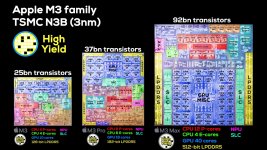Yes, that and the 273GBps memory are better than even optimistic predictions.
And what about TB5??? I would have bet against that. The chip is a tour de force.
Now, as for the Max, I see four options:
1) Just more GPU, same mask as Pro, uncut. I hope not, but plausible. Same idea as M1.
2) Just more GPU, same mask... but, the sixth P core in each cluster is enabled. So, 12P + 4E.
3) Another P cluster, more GPU. 15 or 18 P, 4 or 6 E. 30-40 GPU cores. Still the same mask.
4) Different mask, all bets are off.

